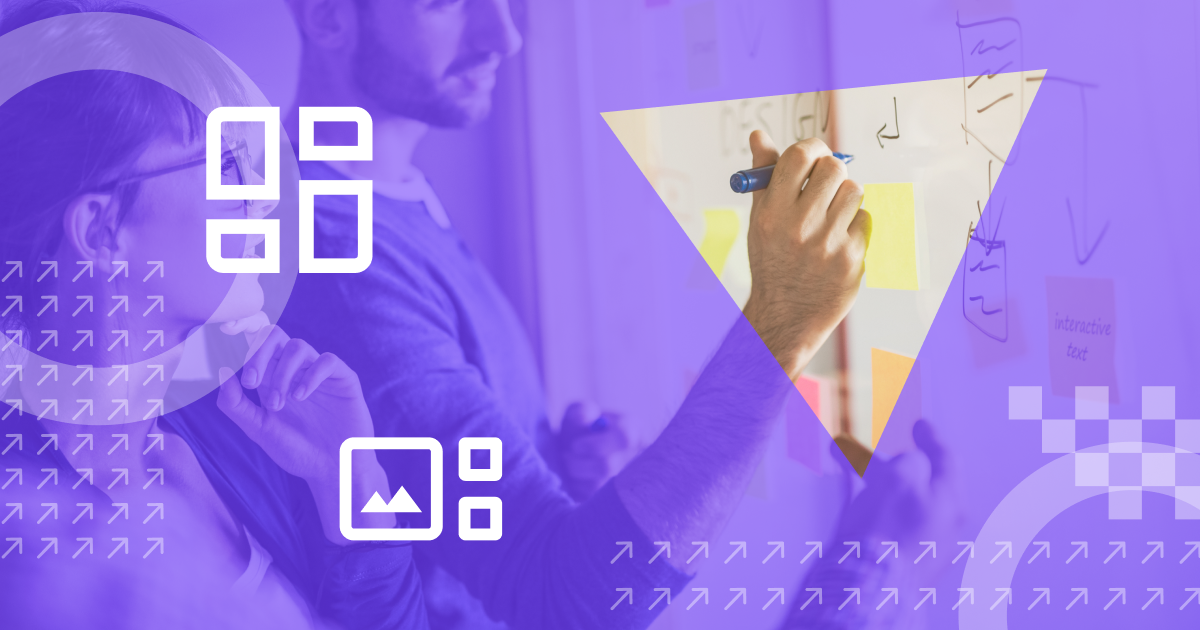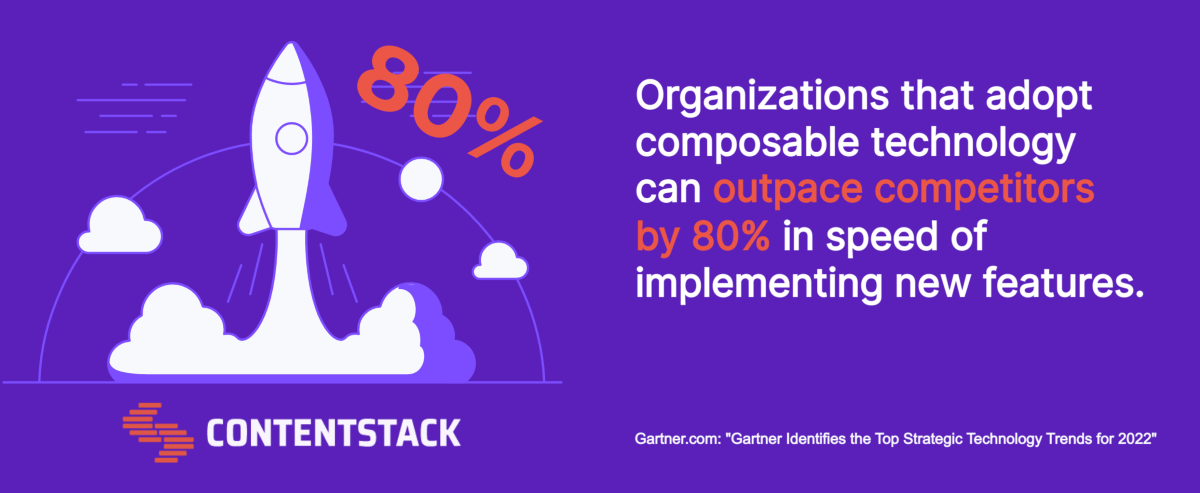Composable DXPs: Core features for digital success

Discover the key features of a DXP in composable environments and how it supports digital transformation. A composable DXP offers excellent value, boosting business agility, flexibility and scalability. Elevate your digital strategy today by switching to a composable DXP. Request a free demo to get started.
Highlights
You’ll learn about the core features of DXPs in composable architectures:
- Modular architecture: Built with small, independent, and reusable components
- API-first design: Built on APIs to facilitate integration and interoperability
- Microservices: Breaks up the application into small, independent modules
- Personalization: Tailors digital experiences to individual user preferences
A composable DXP redefines digital experience platforms by offering robust customization and integration capabilities. Request a demo to see how it works.
Keep reading to learn more!
A recent Qualtrics research states that digital leaders have three top priorities, which are:
- To create a cohesive customer journey across all channels and devices (21%),
- To innovate (17%), and
- To improve organizational processes (17%).
Composable DXPs are driving these business strategies, and analysts believe more organizations will go composable.
But what makes a DXP composable? It is the modular architecture. A regular DXP is integrated software that includes everything in one package. However, a composable architecture is distributed, and you have multiple independent services that interact via APIs.
Features of DXPs in composable architecture
Composable DXPs are typically modular and API-first. They publish content using a headless system and rely on a microservices approach, which are the main features that differentiate them from monolithic DXPs.
There are also other important features, as you will see below.
- Personalization features
- Analytics and reporting tools
- Integration with third-party services
Here is a breakdown of the main features of a DXP in composable architecture.
Modular architecture
The principle of modular design is simple. You build a system from small, independent, and reusable components. This has many benefits. For instance, your team can work on different parts of the system in parallel, which speeds up the time it takes to deliver updates and features.
It also offers security benefits because modules are independent, and an issue in one module does not affect the whole system. So, you can isolate or fix faults without overhauling the system.
API-first approach
The API-first approach involves developing the APIs before building the system. This approach allows all parts of your business to adapt to the DXP for multiple uses through APIs, which is good news for developers as it allows them to build more resilient platforms.
The API-first approach also improves collaboration among your team, facilitates seamless data flows, and enables you to integrate third-party services to enhance the functionality of your composable DXP.
Personalization capabilities
A composable architecture drives personalization in DXPs. It leverages advanced analytics to extract data, which allows you to tailor content and interaction to users' needs.
Components of a composable DXP
This is not the same as the features of a composable DXP. These tools and systems make up the DXP, and each business will have unique DXP components. They include;
- Content management systems
- API management
- Localization
- Customer data platforms
- personalization
- Search
Every business has its unique style and voice, but they all need to standardize their business capabilities in the backend. These elements work together to create a robust DXP that supports your digital strategies.
Start your free trial with Contentstack today. Transform your brand's digital presence with Contentstack's open MACH architecture and industry-leading technology. Witness a significant reduction in publishing and development time, and elevate your content management. Start your free trial now.
Implementing composable DXPs
Although many processes exist to implement a composable DXP, you can summarize them into three main steps.
Identify your business needs
Focus on what experiences you want to offer. Then, think about the tools that will help you deliver in the most efficient way possible. Those tools and capabilities will form the core components of your composable DXP. Here are a few questions to consider:
- What do our customers want?
- What adds the most value to our customers?
- How do the customers interact with our brand?
- How are the customers consuming content today?
These questions help you to get a clearer perspective of what matters to your business.
Choose the right tools
Selecting the right tools is critical when building a composable DXP. Select tools that align with your business needs.
Consider potential growth and expansion and choose scalable systems. Ensure they can integrate with your current system. Also, consider security and go with tools that adhere to security and compliance standards.
Integrate third-party systems
Third-party systems allow you to boost DXP performance with new functions. And with modularity, you can integrate systems from any vendor of choice. You can also future-proof your DXP by integrating it with the latest technologies or services.
You can integrate anything from social media platforms to CRM, payment gateways, extra security, Etc.
Benefits of composable DXPs for organizations
Here are the main benefits for your business when you go from a monolithic DXP to a composable DXP.
- Better security: The modular design and API-first approach provide extra security. An issue or attack in one module does not affect the entire system, so faults can be identified and isolated quite easily, leading to system security and stability.
- Omnichannel delivery: Composable DXPs boost omnichannel strategy. That way, you can reach your audience with tailored content on all channels.
- Faster time to value: On top of being agile and scalable, Composable models are quick to pivot. You can quickly adapt to new market demands or changes in technology without upsetting your existing operations.
- Better customer experiences: Whether you deliver omnichannel or tailored and personalized content, it is all about the customers. Composable DXPs give you the tool to prioritize your customers, which leads to a fulfilling experience for them.

Future of digital experience platforms
More businesses will aim to enrich their DXP through deeper third-party integrations. A G2 Research also reiterates that, stating that users prefer more integration options when choosing a DXP.
Aside from that, you can also expect more businesses to go composable. Expanding omnichannel delivery and enriching customer journey mapping will drive this. To that effect, Gartner also predicts that around 70% of organizations will acquire composable DXP technology by 2026, compared to 50% in 2023.
More organizations will also use AI to deliver more tailored experiences. An Adobe 2024 survey revealed that two out of every three customers were frustrated because brands did not prioritize their preferences. AI will offer a proactive approach to tracking and predicting customer needs based on their interactions with brands.
Finally, AR/VR and the Internet of Things may get more mileage in DXPs as businesses seek to provide more immersive experiences.
Contentstack: Your partner in scaling digital experiences. Twice named a Leader in Forrester's composable DXP award, Contentstack offers an innovative approach to DXP. Experience our 100% microservices architecture and API coverage that allows instant scalability. Start your free trial today.
Case studies
Dawn Foods
Before 2019, Dawn Foods handled orders via phone and in person. The channels were not integrated, and efficiency was low.
By switching to Contentstack’s composable DXP, they boosted digital customer experience and grew online orders by 50%. They also enjoyed seamless e-commerce integration and omnichannel delivery.
Gireesh Sahukar, Vice President of Digital, was ecstatic about the results. Hear from him. "We know that we have made a really good decision choosing Contentstack. We’re extremely happy with our partnership. The kind of flexibility that Contentstack offers, not just to us, but also to the ecosystem partners that we want to work with, is pretty fantastic."
Here is how Dawn Foods found a recipe for success.
Waltz Health
Waltz needed to sync product data, pricing and branding assets templates to create a new, unified marketplace.
Their legacy system could not handle it, so they turned to Contentstack's composable DXP with a headless CMS. The change enabled them to launch new marketplaces 75% faster.
Hear from Sunil Kripalani, the Chief Technology Officer. "The flexibility that's baked into Contentstack isn't just enabling our staff to work more efficiently, it's a true business enabler that's helping us consider new service offerings. Using APIs, we can pull in new data streams and create unique experiences for our provider partners, as well as within niche markets."
Read more about Waltz Health's integration success.
FAQ section
How does a composable DXP support API integration?
A composable DXP supports API integration through its modular design. Since the design principle prioritizes APIs, every component or service can only be accessed and managed via secure and standard API calls.
What are the main components of a composable DXP?
A composable DXP uses the headless CMS for content delivery, and there is a search and discovery tool to help you get to data faster. Other components include analytics tools, customer data platforms, and personalization engines.
What are the benefits of modular architecture in DXPs?
A modular architecture offers technology freedom, meaning you choose any solution from any vendor. It is also flexible, agile, and scalable. It supports innovation, faster updates, and fault isolation, which improves security.
How can a composable DXP enhance omnichannel delivery?
A composable DXP handles data in real-time, which allows you to keep up with customers. It allows you to deliver consistent and timely brand messaging on all channels. It extracts data from customer interactions with which businesses can tailor content.
Learn more
Simply put, if you want to step ahead of your competitors and future-proof your digital strategy, a composable DXP is your best bet. The data points to that. Gartner states that 80% of businesses that adopt composable tech will outperform their competitors.
The composable architecture is tailor-made for omnichannel strategy, third-party integrations, and personalized content delivery. It also supports digital transformation in ways that monolithic DXPs cannot.
It offers technology freedom, and it is future-proof—you can plug and play any new technology. Boost your digital strategy today and take a step into the future. Request a free demo to get started.
About Contentstack
The Contentstack team comprises highly skilled professionals specializing in product marketing, customer acquisition and retention, and digital marketing strategy. With extensive experience holding senior positions in notable technology companies across various sectors, they bring diverse backgrounds and deep industry knowledge to deliver impactful solutions.
Contentstack stands out in the composable DXP and Headless CMS markets with an impressive track record of 87 G2 user awards, 6 analyst recognitions, and 3 industry accolades, showcasing its robust market presence and user satisfaction.
Check out our case studies to see why industry-leading companies trust Contentstack.
Experience the power of Contentstack's award-winning platform by scheduling a demo, starting a free trial, or joining a small group demo today.
Follow Contentstack on Linkedin





.svg?format=pjpg&auto=webp)
.svg?format=pjpg&auto=webp)
.png?format=pjpg&auto=webp)






.png?format=pjpg&auto=webp)


